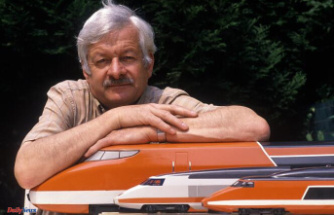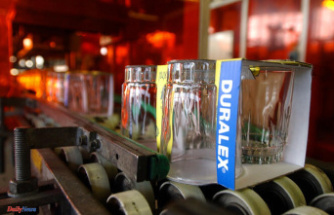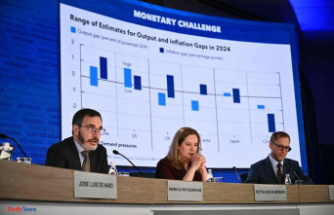For some time now, cheaper smartphones have no longer had to hide behind the flagship models of the major manufacturers. Because many functions of the top devices are already available in smartphones that only cost half as much as the Pro models from Apple and Samsung.
With the Nothing Phone (1) and the Google Pixel 6a, users now have the choice between two new smartphones that are attracting a lot of attention. WELT had both devices compete against each other in the test.
Google has long since found its own design language with its Pixel smartphones, which is characterized by the horizontal camera bar on the back. In general, this is the place where device designers can still let off steam, because the front of most smartphones today is completely covered with a display.
Even though Google has given its Pixel 6a an aluminum frame, the back is made of plastic. "But you don't want to touch plastic," says Carl Pei, the head of Nothing, who previously co-founded Oneplus. That's why the Nothing Phone (1) has scratch-resistant Gorilla Glass 5 on the front and back. You have to know that, because you can't really feel the difference between the two model backs.
Nevertheless, Nothing has come up with something special that no other smartphone has: The back is transparent. This not only looks interesting, it also serves a purpose. Because there are 900 micro-LEDs that can signal individual light patterns individually or in groups and synchronize them with ring tones. Nothing calls this a glyph interface that lights up on calls and notifications.
In this way, lighting patterns can be assigned to different contacts. The user can then see who is calling, even if the device is muted. Provided the smartphone is face down on the table. The LEDs can also display the charging status and be switched on when recording a video to provide light.
It will be interesting to see what else Nothing comes up with for this. Even if the rest of the phone (1) looks like an iPhone with its angular aluminum frame, nobody will ever confuse the smartphone with another model because of the back.
Even with mid-range devices, the manufacturers often outdo each other with the number of camera lenses on the back. Nothing and Google don't go along with it, both have opted for a dual camera with wide-angle and ultra-wide-angle. Google has done so much with the software and algorithms on its Pixel phones in the past that the cameras on these smartphones are among the best on the market.
In comparison, both models deliver good results. The quality of the photos is comparable in sufficient light, in low light the Pixel 6a shows more detail in the shots. Although both devices can also zoom, the optics don't do that, so the quality drops significantly the more the image is zoomed in. The difference to the top devices from the competitors, which have their own built-in camera, is particularly noticeable here.
There are differences in filming. Although both models can take pictures in the high 4K resolution, the Nothing Phone (1) unfortunately only takes 30 frames per second. The Pixel 6a creates twice as many, the videos then appear smoother. The reason for this is probably the more powerful Tensor chip from Google, which is in the Pixel 6a. An adapted Snapdragon 778G works in the Nothing Phone (1), which belongs more to the mid-range segment.
However, the Pixel with the ultra-wide-angle camera can only film in the weaker Full HD resolution; the phone (1) can still manage 4K with the ultra-wide-angle. Conversely, the Pixel 6a from Google delivers more contrast in its 4K recordings with the HDR function. Nothing can do that only when recording up to Full HD. The phone (1) has a resolution of 16 megapixels for the selfie camera, which is twice as high as that of the Pixel 6a.
At first glance, the displays are very similar: with more than 400 pixels per inch, they are sharp and colorful. Both have a fingerprint sensor under the display. The Nothing Phone (1) has a 6.55 inch (16.6 centimeter) OLED display, the bezel is symmetrical and narrower than the Pixel 6a, which has a 6.1 inch (15.5 centimeter) OLED display. screen has.
The difference when scrolling through websites is striking. The display on the phone (1) is smoother here, which is due to the refresh rate of 120 frames per second (Hertz). The Pixel 6a only reaches 60 Hertz.
Fortunately, both manufacturers do without bloatware, i.e. unnecessary and pre-installed apps that other manufacturers overload their devices with because the developers pay them to do so. The Pixel 6a runs on the unchanged Android 12, of course, but the Nothing Phone (1) has also held back from changing Android 12.
Small adjustments are only in the quick settings and the configuration for the glyph interface. Nothing promises Android updates for another three years and security updates for four years. Google typically provides at least three years of Android updates and at least five years of security updates for its Pixel smartphones.
However, the Pixel has some software features that users of the Nothing phone might be jealous of. This allows the recorder app to transcribe your recordings in real time. This also works in German and even recognizes the punctuation. This worked very impressively in the test.
The Pixal 6a also masters live translation - across the app. This works in WhatsApp, Signal, Twitter, Instagram and Snapchat, among others. Even foreign language videos or audios are translated with subtitles. In the Google photo app, users of the Pixel 6a also have the option, for example, of reliably removing people who are bothering them in the background with a “magic eraser”.
Both smartphones have enough power for the whole day, the Pixel 6a comes with a battery of 4400 milliampere hours (mAh), the Nothing Phone (1) has slightly more with 4500 mAh. While the Pixel 6a can be charged with 18 watts via a cable, it is 33 watts for the Nothing Phone (1). This means that the battery can be completely filled within an hour.
The Pixel competitor even supports wireless charging with 15 watts, for which the Snapdragon chip has been specially adapted. And if you have earphones that can be charged wirelessly, you can also do this with the Nothing Phone (1) as a power dispenser, because the model can also charge in reverse, but then only with five watts.
Both smartphone models are powerful, but each of them has strengths and weaknesses. Users have to decide how important wireless charging is to them, which is only possible with the Nothing Phone (1). The glyph interface is also a real eye-catcher. As a newcomer, Nothing is the challenger here, while Google presents a solid device with the Pixel 6a, which is also much better protected against water and dust.
And it can do some impressive tricks via its software that are unlikely to ever come to the Nothing Phone (1). The Pixel 6a is only available in one configuration with six gigabytes of RAM and 128 gigabytes of internal storage. It costs 459 euros. The Phone (1) from Nothing is available with eight or twelve gigabytes of RAM and 128 or 256 gigabytes of internal memory for between 469 and 549 euros.
"Everything on shares" is the daily stock exchange shot from the WELT business editorial team. Every morning from 7 a.m. with the financial journalists from WELT. For stock market experts and beginners. Subscribe to the podcast on Spotify, Apple Podcast, Amazon Music and Deezer. Or directly via RSS feed.












